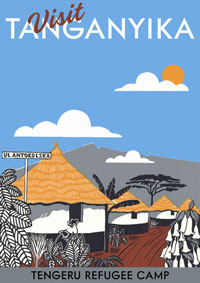
Art and artivism have become powerful ways of shaping how we visualise forced migration. Take, for example, Little Amal, a 12 foot puppet of a 10 year old Syrian refugee child. The centrepiece of the Walk with Amal project, this ‘little girl on a big journey’ has travelled over 9000km, visiting 13 different countries. As the project website, explains, ‘her journeys are festivals of art and hope (her name means ‘hope’ in Arabic) that draw attention to the huge numbers of children fleeing war, violence and persecution, each with their own story. Her urgent message to the world is “Don’t forget about us”.’
Or consider artist George Butler’s recent book, Drawn Across Borders, which we feature in this podcast. One of George’s aims is to address some of the pernicious myths that exist around refugees, to get us thinking differently about what they are queuing for, and to humanise their experiences. As reviews of this book have underlined, it is ‘a work of art, compassion and activism, with journalist and illustrator Butler using his craft to bear witness to and build awareness of the effects of war on civilians whose lives are treated as mere collateral for those in power.’

At the heart of our own Visualising Forced Migration project is a newly commissioned art installation, Diana Forster’s Somewhere to Stay. Diana has spent the last few years experimenting with the ways in which different visual media can communicate the unimaginably shocking rupture of forced migration. Through woodcuts, sculpture, line drawings and ironic posters, she has captured many different aspects of displacement – from imprisonment, hard labour and hunger to self-care and other sources of support. We encourage you to compare her techniques in Depicting Displacement with her new art installation. You can also read about her conflict art here, and listen to this podcast where she discusses her work.
How does the imagery in her different pieces compare with your habits of visualising forced migration? What colours, settings and aesthetics do you associate with refugee experiences? What place does humour or irony have in visualising forced migration? And what kind of art might you create yourself, if you were narrating a refugee story like Anna Sokulska Forster’s?
We also feature some other art initiatives on this website, including work by Rana Ibrahim and the Iraqi Women, Art and War group, which you can explore here. Student Maddie McCall reflects in this blog on art as an inclusive teaching tool for young children, and on the emotional impact of colours in popular media such as comics; and another student, Marios Diakourtis, discusses representations of displacement in art and poetry in ‘Drawing Displacement’. We are interested to hear about examples of art or artivism which have changed how you visualise forced migration. Please do get in touch via our ‘contact us‘ page to tell us about them!
’I feel that art is the best way to express ourselves as refugees and forced immigrants, and it helps us keep our identity alive for the new Iraqi generation.’
Rana Ibrahim, founder of Iraqi Women, Art and War